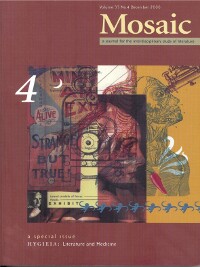Issue 33.4
Overview

Special Issue: Hygieia: Literature and Medicine
Published: December 2000
View the issue introduction or see the issue summary and contents below.
12 essays, totalling 220 pages
$17.95 CAD
This special issue of Mosaic brings together literature and medicine in ways that do not subsume one to the other: there is no oppositional structure as such. Among the twelve essays are entries addressing topics of gender, race, culture, AIDS, disease, pollution, and representation. These topics are explored and developed in conjunction with readings of William Faulkner, Dalton Trumbo, Arthur Conan Doyle, cultural stories, legends and tales, and various medical documentations from a broad period of time.
Lazarus Machine: Body Politics in Dalton Trumbo’s Johnny Got His GunTim Blackmore Modernity and postmodernity understand total war, medicine, and the loss of the body differently. This essay examines the way Dalton Trumbo’s Johnny Got His Gun, both a modern and postmodern text, considers the complicity of the medical community in furthering total war. | |
Arthur Conan Doyle as Doctor and WriterJames Krasner Medical ethicists have recently addressed the use of storytelling in medical practice. This essay examines the medical and detective fiction of Arthur Conan Doyle, a doctor turned writer, to demonstrate the value of a narrative approach to engagements between doctor and patient. | |
Medical Body and Lived Experience: The Case of Harriet MartineauAnka Ryall Focussing on the slippage between clinical diagnoses of gynaecological illnesses and ideologies of gender, this essay, by examining two incommensurable narratives of the bodily experiences of the nineteenth-century British writer Harriet Martineau, raises questions about issues of medical and epistemic authority. | |
“The Future is History”: 12 Monkeys and the Origin of AIDSDavid Lashmet Set at the start and end of an epidemic plague, Terry Gilliam’s 1996 film conflates schizophrenia, hypochondria, carceral confinement, and unregulated experimentation. But these timeless themes have a singular locus: the ultimate truth of a fictional virus. In turn, this locus positions 12 Monkey in a historical frame: within contemporary discourse on the origin of AIDS. | |
The Anatomy of Influence: Robertson Davies’s Psychosomatic MedicineCynthia Sugars The Cunning Man is Robertson Davies’s exploration of the overlapping fields of literary criticism and medicine. This essay argues that, although Davies’s doctor protagonist attests to the influence of a prior cross-disciplinary study, Robert Burton’s 1621 The Anatomy of Melancholy, the primary but unacknowledged intertext is Northrop Frye’s Anatomy of Criticism. | |
“Between Two Moons Balanced”: Menstruation and Narrative in The Sound and the FuryDana Medoro Drawing on Jacques Derrida’s Dissemination, this essay argues that Faulkner’s The Sound and the Fury connects writing, healing, and bleeding. The text’s “menstrual economy” sets the Compson daughters’ therapeutic narrative within the dominant, although fragmentary, chronicle of the Compson sons’ despair and ruin. | |
From Spectacular to Speculative: The Shifting Rhetoric in Recent Gay AIDS MemoirsDavid R. Jarraway The palpable shift from pathology to prevention of AIDS throughout North American culture manifests a gradual alteration in public opinion in recent years. By distinguishing between “spectacular” and “speculative” forms of discourse, this essay traces a parallel rhetorical shift in exemplary forms of the gay AIDS memoir. | |
Venus Live! Sarah Bartmann, the Hottentot Venus, Re-MemberedAnca Vlasopolos Venus Hottentot, whose name and origin remain in doubt, was exhibited as an exotic in London and Paris early in the nineteenth century. Indignities to her body continued after her death. Nevertheless, Venus has exerted immense erotic fascination for the Western world, reflected for two centuries in fashions, paintings, and literature. | |
“carvin’ white folks”: Faulkner, Southern Medicine, and Flags in the DustKirk Melnikoff Tracing the eclectic history of medicine in the South over the past 200 years, this essay reads William Faulkner’s first Yoknapatawpha novel, Flags in the Dust, as an illuminating sociolinguistic portrait of the psychological and cultural consequences of medicine’s modernization in the early twentieth century. | |
Raven’s Plague: Pollution and Disease in Lee Maracle’s RavensongJudith Leggatt This essay examines the paradoxical construction of dirt and disease in Lee Maracle’s Ravensong. The diseases that infect the Salish and European-Canadian communities in the novel represent both bridges to communication between groups and the gulf that separates them. | |
Prescriptions: The Semiotics of Medicine and LiteratureRobert D. Tobin Both medicine and literature are signifying systems that include fundamental ambiguity, a semiotic strategy of interpreting symptoms, a narrative and mythologizing urge, and the creation of categories through performative speech acts. When literature portrays medicine, it therefore has the opportunity to comment upon signification itself. | |
Arrowsmith Goes Native: Medicine and Empire in Fiction and FilmLisa L. Lynch This essay examines how evolving perceptions of America’s role as a world power in the interwar period affect representations of medical research and practice. It argues that Sinclair Lewis’s novel Arrowsmith, and the film based on that novel, construct an imperial role for the United States in their depictions of American scientific medicine. |